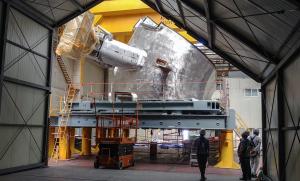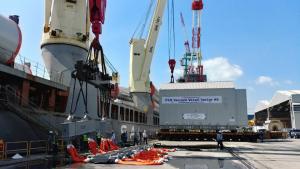Vacuum vessel sector #6
On its way
30 Jun 2020
A 440-tonne, 40-degree sector of the ITER vacuum vessel left Busan, Korea, on Sunday 28 June.
Before leaving the Hyundai Heavy Industries factory in Ulsan, Korea, the 440-tonne sector was wrapped and inserted into protective casing. Sector #6 is seen on its side in this photo with one of its two port stub extensions visible.
A unique component has taken to the sea—one that was more than ten years in the making.
As the first of four sectors to be procured by the Korean Domestic Agency, vacuum vessel sector #6 was the first to progress through every pre-manufacturing, manufacturing, and testing phase. The component's complex geometry, a high number of interfacing parts, strict tolerances, and nuclear safety compliance requirements only increased the challenge for the manufacturing team at Hyundai Heavy Industries. As a first-of-a-kind component, it was also important to create a rigorous documentation trail—both to inform the manufacturing of other sectors, and to facilitate the component's integration into the machine once at ITER.
Thanks to lessons learned on sector #6, three other sectors—#7, #8 and #1—are all at an advanced stage of manufacturing in Korea (>75 percent). Five other sectors are in fabrication under the responsibility of the European Domestic Agency.
Vacuum vessel sector #6 is loaded on board the "REGINE" on 26 June. Shipment to France should take just under one month.
When it arrives at ITER later this summer, sector #6 will be brought into the Assembly Building and transferred by overhead crane to a laydown area. After a final helium leak test and site acceptance test, the component will be ready for handover to the ITER Organization assembly contractor responsible for the vessel (TAC2) for a number of initial activities such as the installation of diagnostics, instrumentation and cable trays.
From there, the component will be transferred to the sector sub-assembly tool for assembly with toroidal field coils #12 and #13, and sector-specific vacuum vessel thermal shields.



